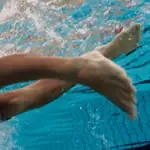 From TriFuel
From TriFuelIt can be quite intimidating to sit down with the triathlon race calendar and figure out which races you can effectively add to your schedule, which triathlons you can be ready for without overtraining, and whether you're racing "too much" or "too little". So here are six simple steps to plan your triathlon race season, straight from the Rock Star Triathlete Academy.
Triathlon Race Season Step 1: Make a list and write down all the races you want to do. Now, choose the three races that are most important to you and dearest to your heart. These three races are going to be your "high priority events". Mark these with an A, a "High", a star, or whatever method you'd like to set them apart. Choose the races that you're "on the fence" about, and mark those with a B, or "mid" priority. Finally, pick the races that you just want to do for fun, and mark those with a C or "low" priority.
Triathlon Race Season Step 2: If your A race is a sprint or an olympic, make sure that you plan 1 week before that race and mark that week with a "taper". If your A race is a Half Ironman, make sure your plan 10-14 days before that race and mark those 10-14 days with a taper. If your A race is an Ironman, plan 2-3 weeks before that race and mark those weeks as a taper. Don't plan any other races during any period of your calendar marked
"taper".
Triathlon Race Season Step 3: Count backwards from the taper for 4 weeks from a Sprint, 6 weeks from an Olympic, and 8 weeks from a Half IM or IM triathlon. During those periods of weeks, plan one to two B-C events to help you mentally and physically prepare for your A event.
Triathlon Race Season Step 4: Count forwards 1 week after a Sprint or Olympic race, 2 weeks after a Half-Ironman race, and 3 weeks after an Ironman race, and mark these periods as "recovery". Don't plan any races during the recovery.
Triathlon Race Season Step 5: Take the 5-11 weeks with the B races to the taper week to the A race to the recovery week(s) - this entire period of time is to be considered one "block". Depending on how long your season is, and how long your races are, you may be able to fit 2-5 "blocks" into an entire triathlon season.
Triathlon Race Season Step 6: Put in 8-12 weeks of foundation "endurance" or "base" training leading up to that first block.
OK, ready for an example of a "3 block" triathlon race season?
February-April: 8 Weeks base training
April-mid-May: Block 1 - 4 weeks build with one B Sprint Triathlon and one A
Sprint triathlon + taper week + recovery week
mid-May-mid-July: Block 2 - 6 weeks build with one B Sprint Triathlon, one C
Olympic triathlon and one A Olympic triathlon + taper week + recovery week
mid-July-mid October: Block 3 - 8 weeks build with one B Olympic Triathlon,
two C Sprint triathlons and one A Half-Ironman triathlon + 2 taper weeks + 2
Recovery weeks

















